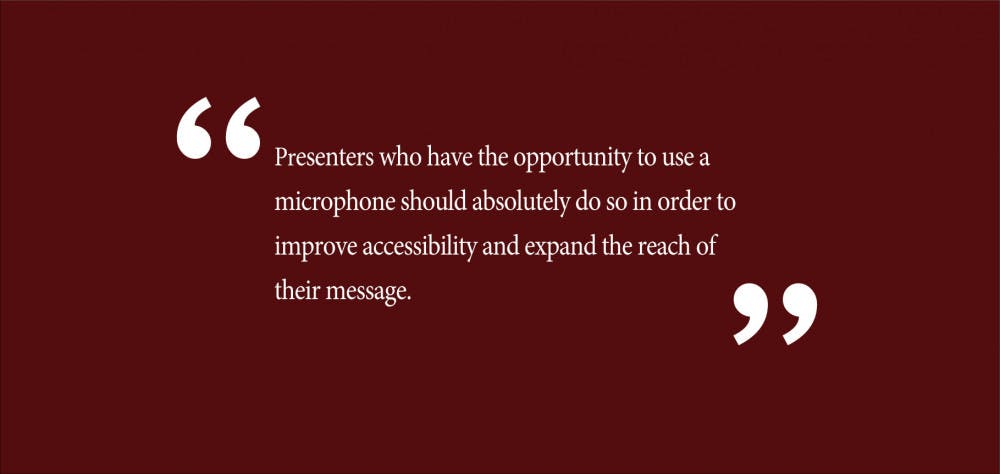Many academic institutions are attempting to increase accessibility, considering everything from the design of campus buildings to accommodations at conferences and workshops. But modifying infrastructure can only do so much to ensure that an event or lecture is accessible if everyone doesn’t adjust their behavior. For example, speakers at these events often ignore the importance of the microphone — which makes lectures more accessible to people with hearing loss. Presenters who have the opportunity to use a microphone should absolutely do so in order to improve accessibility and expand the reach of their message.
Five percent of the global population has disabling hearing loss, and the World Health Organization estimates that this number will roughly double by 2050. Further, 15 percent of adults 18 years old and over in the United States have documented difficulty hearing, with incidence generally increasing with age. Likely there will be a number of students in a class or participants in a workshop with some degree of hearing loss.
Consideration of hearing difficulties is especially important since the point of many of these academic activities — workshops, conferences, lectures — involve sharing information with a distinctly aural component. Inaccessibly low-volume presenters prevent information from being shared, which defeats the point of the entire endeavor. It effectively excludes those with hearing issues, preventing their participation in discussions. As hearing loss is frequently an invisible disability, we often have no idea how many people are excluded in such circumstances.
I was at a workshop recently where there was only one microphone attached to a lectern and the panel of three speakers were all seated far away. Rather than standing to give their presentations and responses at the mic, one panelist said she would just try to talk loudly and that we could let her know if she needed to be louder by raising our hands. This immediately struck me as an unfortunate plan at a workshop where people were raising their hands all the time in order to contribute to the discussion — how do you identify people who are having problems with hearing from people who are seeking to participate? But more importantly, asking individuals with difficulty hearing to identify themselves publicly seems like a terrible way to ensure accessibility. Unsurprisingly, I didn’t hear much of her contribution to the workshop, even though I do not have documented hearing loss.
Too often, when speakers eschew the microphone they do so while extolling their own ability to speak loudly. But using a microphone isn’t only about increasing volume — it’s also about retaining a directionality of speech. During presentations, speakers will often turn their heads to focus on different portions of the audience — or, more likely, to look at the visuals they’re displaying. Even those who are great at projecting their voices are directing their sound toward only a portion of the audience, which means that even loud speech may sound quieter to certain listeners. In contrast, when speaking into a mic, the sound always comes out of the speaker.
More often than not, people think they speak more loudly than they actually do or they peter out after the first few minutes. Even audience members without hearing loss may eventually have to work to understand what is being said.
Additionally, microphones improve audio recording quality by capturing the speaker’s voice directly, with limited interference from ambient noise. The question of accessibility is much more important, but it is worthwhile to note that not only is it better for their audience to use a mic, it also is better for the lecturer. A high- or better-quality recording is valuable on the job market and for those who are interested in sharing their work digitally to reach a broader audience.
I encourage speakers to avoid thinking about a presentation as the opportune moment to showcase their unimpeachable skills in projection, and instead note that it will be easier for their audiences to hear them, and thus engage with their message, if they just use a microphone. It’s not admitting a weakness, it’s embracing a tool that allows speakers to reduce wear on their own voices and help ensure the accessibility of their messages. Ultimately, as Jessie Ramey, an associate professor at Chatham University, explains “It’s not about how you feel using a microphone. It’s about how others can best hear.”
Microphones are not always available. Many lecture halls don’t provide them, and some workshops and conferences are small enough that they may not be necessary. But for those times where a microphone is available, speakers should be sure to use it. Organizers that are planning large gatherings should work with their venue to ensure that a microphone will be available and that any necessary troubleshooting can be taken care of quickly. Here at Brown, the IT Service Center can loan out microphones and work with anyone to ensure their correct use. Ultimately, it’s a small change that can make a large difference in accessibility.
E.L. Meszaros GS can be reached at e.l.meszaros@brown.edu. Please send responses to this opinion to letters@browndailyherald.com and op-eds to opinions@browndailyherald.com.





